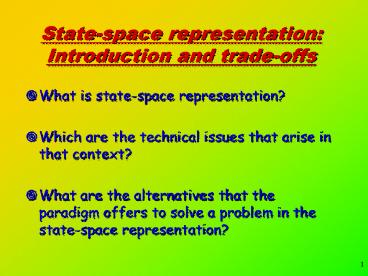Statespace representation: Introduction and tradeoffs - PowerPoint PPT Presentation
1 / 17
Title:
Statespace representation: Introduction and tradeoffs
Description:
Example: The water jugs problem: Given: 2 jugs: Problem: fill the 4 l jug with 2 l of water. ... Rules for the jugs example (2): Fill large from small: ... – PowerPoint PPT presentation
Number of Views:36
Avg rating:3.0/5.0
Title: Statespace representation: Introduction and tradeoffs
1
State-space representationIntroduction and
trade-offs
- What is state-space representation?
- Which are the technical issues that arise in that
context? - What are the alternatives that the paradigm
offers to solve a problem in the state-space
representation?
2
An example Chess
- Problem develop a program that plays chess
(well).
3
Chess (2)
- 2. Describe the rules that represent allowed
moves - Ex.
4
Chess (3)
- 3. Provide a way to check whether a rule is
applicable to some state - Ex.
5
Chess (4)
- 4. How to specify a state in which the goal is
reached ( a winning state) - Ex.
6
Chess (5)
- 5. A way to verify whether a winning state is
reached. - Ex.
7
Chess (6).
- 6. The initial state.
8
Very many issues and trade-offs
- 1. How to choose the rules?
2. Should we search through the implicit tree or
through an implicit graph? 3. Do we need an
optimal solution, or just any solution? optimal
path problems 4. Can we decompose states into
components on which simple rules can in an
independent way? Problem reduction or
decomposability 5. Should we search forwards from
the initial state, or backwards from a goal state?
9
Choice of the rules
- Example The water jugs problem
- Given 2 jugs
- Problem fill the 4 l jug with 2 l of water.
4 l
3 l
10
Rules for the jugs example
- Fill large
- x, y and x lt 4 ? 4, y
- Fill small
- x, y and y lt 3 ? x, 3
- Empty large
- x, y and x gt 0 ? 0, y
- Remove some from large
- x, y and x gt d gt 0 ? x - d, y
- Empty (remove some from) small.
11
Rules for the jugs example (2)
- Fill large from small
- x, y and x y ? 4 and y gt 0 ? 4, y-(4-x)
- Fill small from large.
- Empty small in large
- x, y and x y ? 4 and y gt 0 ? x y ,
0 - Empty large in small.
12
Part of the state space
13
Rules for the jugs example
- Fill large
- x, y and x lt 4 ? 4, y
- Fill small
- x, y and y lt 3 ? x, 3
- Empty large
- x, y and x gt 0 ? 0, y
- Remove some from large
- x, y and x gt d gt 0 ? x - d, y
- Empty (remove some from) small.
14
Part of the state space
15
Problem reduction or problem decomposition
- Ex. Computing symbolic integrals
- State the integral to compute
- Rules integration reduction rules
- Goal all integrals have been eliminated
16
Necessary for decompositionindependence of
states
- Ex. Blocks world problem.
- Initially C is on A and B is on the table.
- Rules to move any free block to another or to
the table - Goal A is on B and B is on C.
17
But branches cannot be combined






























